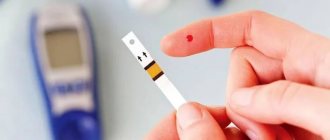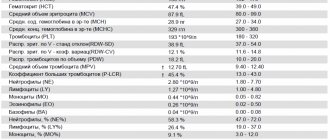Symptoms of high blood sugar can appear at any age. You need to know them in order to go to the hospital in time so that the doctor can prescribe treatment. The normal blood sugar level depends on the age of the person: in infants up to one year old it varies from 2.8 to 4.4 mmol/l, in people older than this age it ranges from 3.3 to 5.5 mmol/l.
When they are higher than these values, they speak of hyperglycemia. It can be caused by various pathological processes in the body; as a rule, elevated blood sugar levels are associated with a disorder of carbohydrate metabolism.
Therefore, it is important to replace the signs of hyperglycemia in time in order to consult a doctor in a timely manner. You also need to know the reasons that can trigger an increase in blood glucose in order to eliminate them if possible.
How do you know if your blood sugar is high?
You can detect high blood sugar with a glucometer, but it can be difficult to detect mild hyperglycemia with its help. Therefore, it is recommended to undergo tests periodically:
- Blood test on an empty stomach. This is an orthotoluidine test that allows you to determine the amount of glucose in the blood. It is carried out in the morning on an empty stomach. 12 hours before donating the biomaterial, you must stop eating, taking medications and exercising. If the test results differ from the norm, the doctor will refer you for additional examination.
- Load method. It is usually performed in a hospital setting. First, blood is donated in the morning on an empty stomach. Then a certain amount of glucose is injected into the patient’s body and after several hours the blood is taken for analysis again. If the results of the secondary test are more than 11 mmol/l, then a diagnosis of hyperglycemia is usually made.
Symptoms of acute complications with unstable glycemia
A diabetic crisis is a forced change in condition in which the concentration of glucose in the blood drops sharply (hypoglycemic crisis) or increases sharply (hyperglycemic complication).
Hypoglycemic crisis
The critical sugar level is 2.8 mmol/l on an empty stomach. With these indicators, the patient experiences the following symptoms:
- tremor, otherwise trembling (involuntary rapid contraction of muscle fibers);
- inappropriate behavior (anxiety, irritability, fussiness, reverse reactions to external stimuli);
- ataxia;
- decreased visual acuity;
- dysfunction of the speech apparatus (slurred speech);
- hyperhidrosis;
- pallor and cyanosis (blueness) of the skin;
- increase in blood pressure and heart rate (heart rate);
- loss of consciousness (short-term or prolonged fainting).
Acute complications of diabetes mellitus can lead to coma
Hyperglycemic crisis
It has three main forms (hyperosmolar, lactic acidotic, ketoacidotic). Symptoms of hyperosmolar crisis: dehydration of the body against the background of polydipsia and pollakuria, skin itching, dizziness, loss of strength (physical weakness). Lactic acid crisis is characterized by the following symptoms: frequent loose stools (diarrhea), heaviness of the epigastric (epigastric) region, reflex release of stomach contents (vomiting), noisy and deep breathing (Kussmaul breathing), a sharp decrease in blood pressure, loss of consciousness.
The ketoacidotic form of the crisis is manifested by symptoms: polydipsia and pollakiuria, asthenia, decreased body tone and physical capabilities (weakness), lethargy and sleep disturbance (drowsiness), the smell of ammonia from the mouth, nausea and vomiting, Kussmaul breathing.
Important! In a state of sudden change in blood glucose concentration, the patient needs urgent medical attention. A crisis carries the risk of developing a diabetic coma and death.
Diabetes mellitus is an incurable pathology. The initial stage of the disease may be asymptomatic, so you need to be attentive to your health, listening to the slightest changes in your well-being. Regular monitoring of sugar levels is a chance to promptly detect the development of the disease.
Causes of high blood sugar
Causes of hyperglycemia can vary, including:
- diabetes mellitus is one of the most common causes of high blood sugar;
- excess somatropin;
- hypercortisolism syndrome, in which there is an enlargement of the pituitary gland and adrenal glands, impaired brain function;
- nicotine addiction;
- alcohol abuse;
- liver dysfunction;
- hard physical labor;
- suffered a heart attack and stroke;
- severe pathologies of the digestive tract;
- dysfunction of the thyroid gland;
- treatment with certain medications, including niacin, rituximab, fentimidine, asparaginase, thiazide diuretics, 1st and 2nd generation antidepressants, glucocorticoids, β-blockers, protease inhibitors, long-term use of birth control pills;
- a large number of sweets and baked goods in the diet;
- premenstrual syndrome;
- deficiency of B vitamins;
- pregnancy;
- epileptic seizure.
There are provoking factors that cause a sharp increase in blood sugar, including:
- burns accompanied by severe pain;
- kidney and pancreas dysfunction;
- pathologies of the gastrointestinal tract;
- diseases that are accompanied by prolonged pain;
- inflammation, which is observed against the background of endocrine pathologies.
Increased blood sugar can be caused by severe anxiety and prolonged stress. The sympathetic nervous and hypothalamic-pituitary systems, adrenal glands and pancreas are responsible for the level of glucose in the body.
Features of the course in girls
Statistics show that women are much more likely to suffer from the manifestations of pathology.
This especially applies to the second type of disease. This is due to the fact that the weaker sex has more adipose tissue, and, on the contrary, less muscle mass than men. The fact is that adipose tissue does not absorb insulin and does not utilize glucose well. Girls are also more susceptible to stress, which provokes the release of steroid hormones and increased glucose levels. A particular danger in the development of pathology is the love of sweets. Frequently eating cakes and pastries leads to an increase in fat. This leads to activation of the disease in women. Girls also develop another type of pathology - gestational. But we'll talk about it later.
Symptoms
The characteristic symptoms of hyperglycemia do not appear immediately. Due to the blurred clinical picture, it is not always possible to suspect a pathology and begin therapy on time. You should go to the hospital to get tested if the following signs appear:
- Intense thirst. This is one of the main symptoms of high blood sugar. Glucose draws water from peripheral tissues and the person feels thirsty all the time. When sugar reaches 10 mmol, it begins to be excreted in the urine, and with it water, which causes frequent emptying of the bladder and dehydration.
- Dry mouth.
- Headaches caused by water-salt imbalance and dehydration.
- Skin itching.
- Weakened vision.
- Numbness and tingling of the fingers of the upper and lower extremities.
- Pain when walking.
- Hands and feet are cold to the touch. This is due to the fact that peripheral blood circulation is impaired.
- Nephropathy.
- Weight gain or loss that is associated with insulin dysfunction.
- Disturbances in the functioning of the digestive tract, which causes stool retention or indigestion.
- Decreased appetite.
- Smell of acetone from the mouth.
- Poor skin regeneration; with hyperglycemia, even small wounds take a long time to heal.
- Heart rhythm disturbances;
- Heavy, restless breathing;
- Fast fatiguability;
- Weakening of the immune system, which causes a person to often get sick.
With severe hyperglycemia, severe dehydration and ketoacidosis develop, and consciousness is impaired. It can cause coma.
The symptoms of high blood sugar in men and women are largely similar, but the latter are more likely to experience:
No. 1 Copious, frequent urination
One of the earliest symptoms of diabetes is polyuria.
If you notice frequent urination and a significant increase in urine volume (especially at night), this is a serious signal to contact a general practitioner or endocrinologist.
The amount of glucose in the blood increases due to slower absorption. As a result, the work of the kidneys increases and they “try” to remove excess glucose into the urine. Water, instead of being absorbed by the body, is intensively removed from it.
How to fix
If you notice symptoms of high blood sugar, you should immediately go to the hospital to identify the cause of hyperglycemia. Depending on the provoking factor, the necessary therapy is prescribed.
Otherwise, hyperglycemia in the human body will lead to irreversible processes and provoke the development of vascular and skin diseases, indolent infections, depression, and sleep problems.
Depending on the cause and severity of hyperglycemia, your doctor may prescribe medications. To reduce high blood sugar levels, it is important to learn how to properly cope with stressful situations and regularly devote time to physical activity.
It is also important to pay special attention to your diet and choose foods with a low glycemic index.
You can include in your diet:
- seafood and lean fish, including lobster, crab and lobster;
- mushrooms;
- cereals;
- vegetables and greens such as cabbage, broccoli, zucchini, radishes, pumpkin, spinach, carrots, tomatoes, cucumbers, bell peppers, celery, asparagus, horseradish, onions, Jerusalem artichoke;
- soy and soy cheeses, including tofu;
- flaxseed, butter and rapeseed oil;
- berries and fruits such as cherries, raspberries, avocados, apples, kiwis, grapefruits and lemons;
- spices such as mustard, cinnamon and ginger;
- legumes, including lentils;
- walnuts, almonds, cashews;
- milk and dairy products, such as low-fat cottage cheese and kefir;
- lean meats;
- eggs, but not more than 1 piece per day.
It is recommended to steam, stew, bake, and boil dishes. Food should be taken in small portions, at the same time, to reduce the risk of a sharp jump in sugar.
Signs in women over 50
Typically, menopause begins at age 50 or older. It disrupts the metabolism in the body, provokes obesity and problems with the cardiovascular system. Also, changes in hormones lead to irritability and stress, which negatively affects the immune system.
This period of life is characterized by the development of type 2. It can be hidden, and you will not understand what signs may indicate the development of the disease. It is important to undergo timely examinations and tests to identify possible problems. This especially applies to those whose parents and other relatives suffered from this disease.
Diabetes mellitus in children
Diabetes mellitus in children is a chronic disorder of carbohydrate metabolism, in which insulin production is disrupted and hyperglycemia develops. When the disease occurs, the child loses weight sharply, despite a good appetite, he is constantly tormented by thirst, and urination becomes more frequent. Typically, children are diagnosed with type 1 diabetes, also called insulin-dependent.
Factors provoking the disease may be the following:
- genetic predisposition;
- viral infections, including measles, rubella, herpes;
- stress;
- artificial or mixed feeding, early introduction of cow's milk and grain crops, monotonous carbohydrate foods;
- surgical intervention;
- baby's weight at birth is 4.5 kg;
- excess weight, physical inactivity;
- diathesis;
- endocrine disorders, including Itsenko-Cushing syndrome, acromegaly, pheochromocytoma;
- pathologies of the digestive tract;
- autoimmune diseases such as rheumatoid arthritis, scleroderma, Libman-Sachs disease, periarteritis nodosa.
Recently, more and more often children are diagnosed with type 2 pathology, the main reasons being excess weight and obesity.
Signs in women over 40
After 40 years of age, there is a danger of developing both type 1 and type 2 disorders. The main reasons for developing this pathology are a sedentary lifestyle and overeating. The autoimmune system begins to attack the pancreas, where insulin is produced. It's not known why, but thin women have a higher risk of developing diabetes without actively developing symptoms.
Insulin injections are rarely required. The main focus of treatment is on a low carbohydrate diet. A healthy lifestyle will help support the body in the fight against the problem. The main thing is not to get caught up in unhealthy sweets and other temptations. Otherwise, all previous treatment will go to waste.











